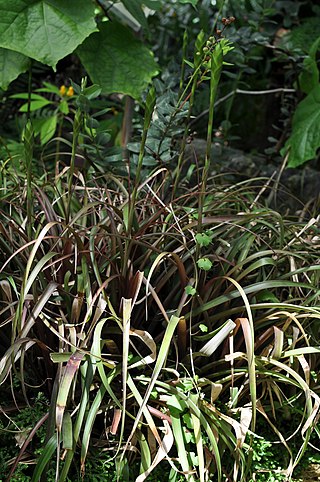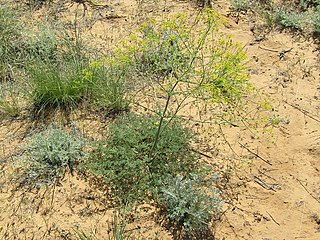
Callirhoe is a genus of flowering plants in the mallow family, Malvaceae. Its nine species are commonly known as poppy mallows and all are native to the prairies and grasslands of North America. Of the nine species, some are annuals while others are perennial plants.

The genus Pulsatilla contains about 40 species of herbaceous perennial plants native to meadows and prairies of North America, Europe, and Asia. Derived from the Hebrew word for Passover, "pasakh", the common name pasque flower refers to the Easter (Passover) flowering period, in the spring. Common names include pasque flower, wind flower, prairie crocus, Easter flower, and meadow anemone. Several species are valued ornamentals because of their finely-dissected leaves, solitary bell-shaped flowers, and plumed seed heads. The showy part of the flower consists of sepals, not petals.

Kohleria is a New World genus of the flowering plant family Gesneriaceae. The plants are generally tropical herbs or subshrubs with velvety stems and foliage and brightly colored flowers with spots or markings in contrasting colors. They are rhizomatous and commonly include a period of dormancy in their growth cycle. The genus was revised in 1992 and was then recognized as having 19 species distributed in Central America and South America. phylogenetic in 2005 indicated that the epiphytic genus Capanea is derived from within Kohleria, and the two species of Capanea were subsequently transferred to Kohleria. The genus Pearcea is closely related.

Edmundoa is a genus of flowering plants in the family Bromeliaceae, subfamily Bromelioideae. It is native to southern and south-eastern Brasil.

Spathiphyllum wallisii, commonly known as peace lily, white sails, or spathe flower, is a very popular indoor house plant of the family Araceae. The genus name means "spathe-leaf", and the specific epithet is named after Gustav Wallis, the German plant collector. It was first described in 1877.

Eduard August von Regel was a German horticulturalist and botanist. He ended his career serving as the Director of the Russian Imperial Botanical Garden of St. Petersburg. As a result of naturalists and explorers sending back biological collections, Regel was able to describe and name many previously unknown species from frontiers around the world.

Heinrich Sylvester Theodor Tiling was a Russian physician and naturalist. During his later years he became an American citizen.

Wallisia lindeniana is a species of flowering plant in the genus Wallisia. It is endemic to Ecuador.
Johann Adam Philipp Hepp was a German physician and lichenologist.

The taxonomy of Tulipa places the genus in the family Liliaceae, and subdivides it as four subgenera, and comprises about 75 species.

Prangos is a genus of flowering plants of the family Apiaceae, native from Europe to Mongolia and the western Himalayas.
Xantheranthemum, known as the golden vein plant or bronze vein plant, is a genus of flowering plants in the family Acanthaceae. It has only one currently accepted species, Xantheranthemum igneum, native to Peru. It is grown as a greenhouse or house plant. There may be some confusion caused by the names of the botanists Linden and Lindau, as some sources associate it with Aphelandra goodspeediiStandl. & F.A.Barkley, along with Chamaeranthemum igneumRegel, Eranthemum igneumLinden, Stenandrium igneum(Linden) André, Stenandrium pictumN.E.Br., and Xantheranthemum igneum(Linden) Lindau.

Psylliostachys is a genus of flowering plants belonging to the family Plumbaginaceae.
Restella is a monotypic genus of flowering plants belonging to the family Thymelaeaceae. It only contains one known species, Restella alberti(Regel) Pobed.
Kaufmannia semenovii is a species of flowering plant belonging to the family Primulaceae. It is the sole species in genus Kaufmannia. It is native to Kazakhstan and Kyrgyzstan in Central Asia.

Galagania is a genus of flowering plants belonging to the family Apiaceae.
Schtschurowskia is a genus of flowering plants belonging to the family Apiaceae.
Schrenkia is a genus of flowering plants belonging to the family Apiaceae.

Elaeosticta is a genus of flowering plants belonging to the family Apiaceae.
Kozlovia is a genus of flowering plants belonging to the family Apiaceae.













